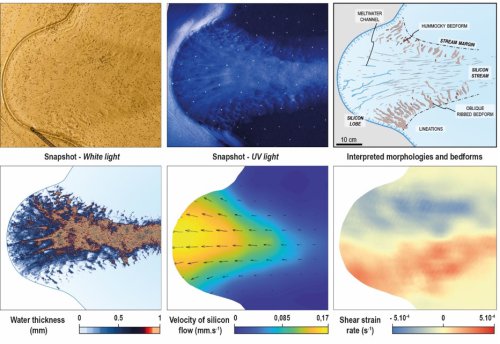What can we learn from the experimental modelling of subglacial hydrology ?
The configuration and evolution of the hydrological system under ice sheets is a key control on ice flow dynamics, erosion, sedimentation and bed deformation. Due to the inaccessibility of the subglacial environment, the understanding of subglacial meltwater drainage and its interaction with the ice and the substratum often relies on numerical modelling and/or analyses of palaeo-ice sheet beds (e.g., geomorphology, sedimentology).
We introduce an innovative and unique experimental model to examine erosion and deformation of the subglacial bed by circulation of pressurized meltwater at the ice/substratum interface. We use a permeable substratum (sand) simulating the subglacial bed partially covered by a viscous, impermeable, and transparent silicon putty cap simulating the ice, below which we apply a central injection of pure water. Modelling results show the formation of drainage landforms and bedforms that are morphologically similar to their natural counterparts observed beneath palaeo-ice sheets. By improving the monitoring devices, we can record the conditions and processes under which the experimental landforms and bedforms develop (deformation of the silicon, silicon flow velocity, drainage configuration, fluid pressure) and apply our findings to ancient and modern ice sheets. These findings are very promising and allow the processes of formation of subglacial valleys, the cycles of ice sheet stabilization/destabilization, the formation of subglacial bedforms or the position of large meltwater drainage routes to be re-investigated.
We introduce an innovative and unique experimental model to examine erosion and deformation of the subglacial bed by circulation of pressurized meltwater at the ice/substratum interface. We use a permeable substratum (sand) simulating the subglacial bed partially covered by a viscous, impermeable, and transparent silicon putty cap simulating the ice, below which we apply a central injection of pure water. Modelling results show the formation of drainage landforms and bedforms that are morphologically similar to their natural counterparts observed beneath palaeo-ice sheets. By improving the monitoring devices, we can record the conditions and processes under which the experimental landforms and bedforms develop (deformation of the silicon, silicon flow velocity, drainage configuration, fluid pressure) and apply our findings to ancient and modern ice sheets. These findings are very promising and allow the processes of formation of subglacial valleys, the cycles of ice sheet stabilization/destabilization, the formation of subglacial bedforms or the position of large meltwater drainage routes to be re-investigated.

Fig. 1. The array of experimental data produced by the physical model developed in le Mans Université. The physical modal is able to reproduce and monitor ice-water-sediments interactions.